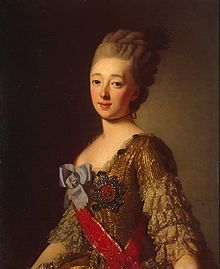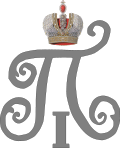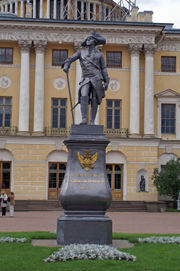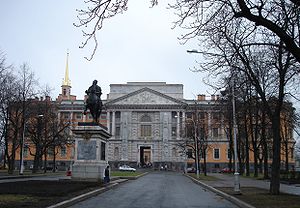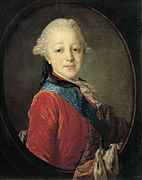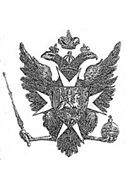- Paul I of Russia
-
Paul I 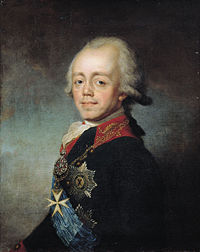
Emperor and Autocrat of All the Russias Reign 17 November 1796 – 23 March 1801 (4 years, 126 days) Coronation 5 April 1797 Predecessor Catherine II Successor Alexander I Duke of Holstein-Gottorp Reign 17 July 1762 – 1 July 1773 Predecessor Carl Peter Ulrich Successor Christian VII of Denmark Count of Oldenburg Reign 1 July – 14 December 1773 Predecessor Christian VII of Denmark Successor Frederick Augustus I Consort Wilhelmina Louisa of Hesse-Darmstadt
Sophie Dorothea of WürttembergIssue Alexander I
Grand Duke Konstantin Pavlovich
Archduchess Alexandra of Austria
Elena, Hereditary Grand Duchess of Mecklenburg-Schwerin
Maria, Grand Duchess of Saxe-Weimar-Eisenach
Catherine, Queen of Württemberg
Olga Pavlovna
Anna, Queen of the Netherlands
Nikolai I
Grand Duke Michael PavlovichFull name Paul Petrovich Romanov House Holstein-Gottorp-Romanov Father Peter III Mother Catherine II Born 1 October [O.S. 20 September] 1754
St PetersburgDied 23 March 1801 (aged 46)
St Michael's CastleBurial Peter and Paul Cathedral Signature 
Religion Eastern Orthodox Paul I (Russian: Па́вел I Петро́вич; Pavel Petrovich) (1 October [O.S. 20 September] 1754 – 23 March [O.S. 11 March] 1801) was the Emperor of Russia between 1796 and 1801. He also was the 72nd Prince and Grand Master of the Order of Malta (de facto).[1]
Contents
Childhood
Paul was born in the Palace of Empress Elisabeth in St Petersburg. He was the son of Elizabeth's heir, her nephew, the Grand Duke Peter, later Emperor Peter III, and his wife, the Grand Duchess Catherine, later Empress Catherine II. In her memoirs, Catherine strongly implies that Paul's father was not Peter, but one of her lovers, Sergei Saltykov. Supporters of Catherine's claim assume that Peter III was sterile, and was unable to even engage in normal sexual relations with her until he had a surgical operation performed, and so could not have sired the boy himself. Although the story was much aired by Paul's enemies, it is possible that this was simply an attempt to cast doubt on Paul's right to the throne, in order to prop up Catherine's own somewhat shaky claim. He physically resembled the Grand Duke so one might doubt the claims of illegitimacy.[citation needed]
During his infancy, Paul was taken from the care of his mother by the Empress Elisabeth, whose ill-judged fondness allegedly injured his health. As a boy, he was reported to be intelligent and good-looking. His pug-nosed facial features in later life are attributed to an attack of typhus, from which he suffered in 1771. It has been asserted that his mother hated him, and was only restrained from putting him to death while he was still a boy by the fear of what the consequences of another palace crime might be to herself. Lord Buckinghamshire, the British Ambassador at her court, expressed this opinion as early as 1764. However, others suggest that the Empress, who was usually very fond of children, treated Paul with kindness. He was put in the charge of a trustworthy governor, Nikita Ivanovich Panin, and of competent tutors.
Her dissolute court provided a bad home for a boy destined to become the sovereign, but Catherine took great trouble to arrange his first marriage with Wilhelmina Louise (who acquired the Russian name "Natalia Alexeievna"), one of the daughters of Ludwig IX, Landgrave of Hesse-Darmstadt, in 1773, and allowed him to attend the Council in order that he might be trained for his work as Emperor. His tutor, Poroshin, complained of him that he was "always in a hurry," acting and speaking without reflection.
Early life
After his first wife died in childbirth, his mother arranged another marriage on 7 October 1776, with the beautiful Sophia Dorothea of Württemberg, given the new name Maria Feodorovna. At this time he began to be involved in intrigues. He believed he was the target of assassination. He also suspected his mother of intending to kill him, and once openly accused her of causing broken glass to be mingled with his food.
The use made of his name by the rebel Pugachev, who had impersonated his father Peter, tended no doubt to render Paul's position more difficult. On the birth of his first child in 1777 the Empress gave him an estate, Pavlovsk. Paul and his wife gained leave to travel through western Europe in 1781–1782. In 1783 the Empress granted him another estate at Gatchina, where he was allowed to maintain a brigade of soldiers whom he drilled on the Prussian model, still an unpopular stance at the time.
Relationship with Catherine the Great
Catherine the Great and her son and heir, Paul I, maintained a harsh and distant relationship throughout the former’s reign. Paul did not see his mother for the first six weeks of his infancy, visiting her only once for prayers. She saw him one year later on Easter. The empress did not mention her son again in her memoirs. It was Catherine’s aunt-in-law, the empress Elizabeth, who took up the child as a passing fancy.[2] After Elizabeth proved an incapable caretaker he was supervised by substantially more inept nannies. Russian historian Roderick McGrew briefly relates the degree of neglect to which the infant heir was subject: “On one occasion he fell out of his crib and slept the night away unnoticed on the floor.”[3] Even after this neglect and in spite of Paul’s rapacious passion for schooling, relations with Catherine hardly improved throughout her reign. In one instance the empress gave to one of her court favourites fifty-thousand rubles on her birthday; Paul received a cheap watch.[4] Paul’s isolation from his mother caused an irrevocable rift between them which would be later reinforced by his reduced status in the imperial court, her favouritism of certain courtiers, and her eventual decision to remove him from succession. His childhood exclusion reappeared later in his relations to the Imperial Court and caused him to oppose her pet policies, but Catherine II’s choke hold on his status restricted not only his mobility as a diplomat and servant of the state but his ability to govern as emperor.
Paul I’s tutor, Count N.I. Panin, was brutally honest in relating to his pupil his station in the Russian court, calling him “a bastard who owed his position to his mother’s sufferance.”[5] This insult set the general tone of Paul’s relationship with Catherine II, a woman who allowed nothing to undermine her control of the empire. This is evident in Paul’s status in the court, which was never of great consequence until he ascended the throne. Grigorii Orlov, one of Catherine’s favoured lovers, went into quarantine shortly following an outbreak of the Moscow plague. For the period that he was gone (late 1772 to 1773) Catherine initiated a “rapprochement” with her son, granting him at last the motherly affection denied him throughout his entire life. McGrew describes the new relationship as follows: “They spent hours together, laughing, talking, and strolling arm in arm. So enraptured was Paul…that he refused even at dinner to be separated from her.”[6] On one occasion he was found altering the place-cards so that he could sit beside her for the evening. In spite of this rise in motherly fondness, Catherine proved to be cold and calculating in earning her son’s affections. Her motives were exclusively political; being that Paul was soon reaching majority and a marriageable age, the empress thought it best if she knew her son better. The rekindling of motherly love was little more than a tactic to establish better connections should disaster occur.[7] When Paul turned eighteen, he was appointed Fleet Admiral of the Russian navy and colonel of the Cuirassier regiment, the latter of which was already granted him in 1762.[8] It is clear that Catherine II had no intention of sharing her power. Paul’s mother was not alone in treating him with unkindness and disrespect; the nobility proved equally adept in making a fool out of their future emperor.
Though Russian rulers’ status as autocrat hinged on the nobility’s contentment, it was equally important for courtiers to remain in the emperor’s favour. This was no different in Catherine II’s reign. Catherine’s absolute power and the delicate balance of courtier-status greatly influenced the courtly relationship with Paul, who openly disregarded his mother’s opinions. Paul adamantly protested his mother’s policies, writing a veiled criticism in his Reflections, a dissertation on military reform.[9] In it, he directly disparaged expansionist warfare in favour of a more defensive military policy. Unenthusiastically received by his mother, Reflections appeared a threat to her authority and added weight to her suspicion of an internal conspiracy. For a courtier to have openly supported or shown intimacy towards Paul, especially following this publication would have been suicide. McGrew enumerates on the courtiers’ attitudes towards the crown prince of Russia: “It was more common, however, for Catherine’s favourites to denigrate Paul, or even to insult him. On one occasion when Catherine was discussing a point with Platon Zubov…she asked what Paul’s opinion was. He replied that he thought as Zubov did, whereupon Zubov mimed surprise and cried, ‘Did I say something stupid then?’”[10]
Paul spent his later years away from the Imperial Court, contented to remain at his private estates at Gatchina and perform drill exercises. As Catherine II grew older she became less concerned that her son attend court functions, her attentions focused primarily on ensuring that Alexander I succeed the throne instead of his father.
It was not until 1787 that Catherine II officially determined to exclude her son from succession.[11] After Paul’s sons Alexander and Constantine were born, she immediately had them placed under her charge, a much more proactive approach than she had made with her own son. That Catherine grew to favour Alexander as sovereign of Russia rather than Paul is unsurprising: the empress made no effort to understand her son until he turned eighteen, and gave him no responsibilities through which to prove him a capable leader and diplomat. During his marriage to Maria Feodorovna, Catherine’s hostility towards Paul was fuelled by a scandalous affair between him and Maria Feodorovna’s maid of honour, Catherine Nelidova. There could be little in the empress’ mind to support the thought of Paul’s reign. Secretly, she met with Alexander’s tutor de La Harpe to discuss his pupil’s ascension, and attempted to convince Maria to sign a proposal authorizing her son’s legitimacy as immediate heir. Both efforts proved fruitless, and though Alexander agreed to his grandmother’s wishes he remained respectful of his father’s position as successor.
Accession to the throne
Paul became emperor after Catherine suffered a stroke on 5 November 1796, and died without having regained consciousness. His first action was to inquire about and, if possible, to destroy her testament, as it was rumoured that she had expressed wishes to exclude Paul from succession and to leave the throne to Alexander, her eldest grandson. These fears probably contributed to Paul's promulgation of the Pauline Laws, which established the strict principle of primogeniture in the House of Romanov and were not to be modified by his successors.
The army, then poised to attack Persia in accordance with Catherine's last design, was recalled to the capital within one month of Paul's ascension. His father Peter was reburied with great pomp at the royal sepulchre in the Peter and Paul Cathedral. Paul responded to the rumour of his illegitimacy by parading his descent from Peter the Great. The inscription on the monument to the first Emperor of Russia erected in Paul's time near the St. Michael's Castle reads in Russian "To the Great-Grandfather from the Great-Grandson", a subtle but obvious allusion to the Latin "PETRO PRIMO CATHERINA SECUNDA", the dedication by Catherine on the 'Bronze Horseman', the most famous statue of Peter in St Petersburg.
Purported eccentricities
Emperor Paul was idealistic and capable of great generosity, but he was also mercurial and capable of vindictiveness. Both qualities, it must be added, which the Russian people greatly favoured as typical of benevolent autocrats of the time.[citation needed] During the first year of his reign, Paul emphatically reversed many of the harsh policies of his mother. Although he accused many of Jacobinism, he allowed Catherine's best known critic, Radishchev, to return from Siberian exile. Along with Radishchev, he liberated Novikov from Schlüsselburg fortress, and also Tadeusz Kościuszko, yet after liberation both were confined to their own estates under police supervision. He viewed the Russian nobility as decadent and corrupt, and was determined to transform them into a disciplined, principled, loyal caste resembling a medieval chivalric order. To those few who conformed to his view of a modern-day knight (e.g., his favourites Kutusov, Arakcheyev, Rostopchin) he granted more serfs during the five years of his reign than his mother had presented to her lovers during her thirty-four years. Those who did not share his chivalric views were dismissed or lost their places at court: seven field marshals and 333 generals fell into this category.
In accordance with his chivalric ideals, Paul was elected as the Grand Master of the Knights Hospitaller, to whom he gave shelter following their ejection from Malta by Napoleon. His leadership resulted in the establishment of the Russian tradition of the Knights Hospitaller (Order of St John/Maltese Order) within the Imperial Orders of Russia. At a great expense, he built three castles in or around the Russian capital. Much was made of his courtly love affair with Anna Lopukhina, but the relationship seems to have been platonic and was barely more than another detail in his ideal of chivalric manhood.
Emperor Paul also ordered the bones of Grigory Potyomkin, one of his mother's lovers, dug out of their grave and scattered.[12]
Foreign affairs
Paul came to power following the death of his mother, Catherine the Great, in late 1796, and his early policies can largely be seen as reactions against hers. In foreign policy, this meant that he opposed to the many expansionary wars that she fought and instead preferred to pursue a more peaceful, diplomatic path. Immediately upon taking the throne, he recalled all troops outside Russian borders, including the struggling expedition Catherine II had sent to conquer Iran through the Caucasus and the 60,000 men she had promised to England and Austria to help them defeat the French.[13] Paul hated the French before their revolution, and afterwards, with their republican and anti-religious views, he detested them even more.[14] In addition to this, he knew French expansion hurt Russian interests, but he recalled his mother’s troops primarily because he firmly opposed wars of expansion. He also believed that Russia needed substantial governmental and military reforms to avoid an economic collapse and a revolution, before Russia could wage war on foreign soil.[15]
Paul offered to mediate between Austria and France through Prussia and pushed Austria to make peace, but the two countries made peace without his assistance, signing the Treaty of Campoformio in October 1797.[16] This treaty, with its affirmation of French control over islands in the Mediterranean and the partitioning of the Venetian republic, upset Paul, who saw it as creating more instability in the region and displaying France’s ambitions in the Mediterranean.[17] In response, he offered asylum to the Prince de Condé and his army, as well as Louis XVIII, both of whom had been forced out of Austria by the treaty.[18] By this point, Bonaparte had seized Italy, the Netherlands, and Switzerland, establishing republics with constitutions in each, and Paul felt that Russia now needed to play an active role in Europe in order to overthrow what the republic had created and restore traditional authorities.[19] In this goal he found a willing ally in the Austrian chancellor Baron Thugut, who hated the French and loudly criticized revolutionary principles. The English and the Ottoman Empire joined the Austrians and the Russians in order to stop French expansion, free territories under their control and re-establish the old monarchies. The only major power in Europe who did not join Paul in his anti-French campaign was Prussia, whose historic neutrality with Bonaparte, distrust of Austria, and the security they got from their current relationship with France prevented them from joining the coalition.[20] Despite the Prussians’ reluctance, Paul decided to move ahead with the war, promising 60,000 men to support Austria in Italy and 45,000 men to help England in North Germany and the Netherlands.[21]
Another important factor in Paul’s decision to go to war with France was the situation with the Island of Malta, the fortress that served as the home for the Order of St. John of Jerusalem, a Catholic order of knights dedicated to fighting the influence of Muslims in the Mediterranean that had existed since the first crusade. In addition to Malta, the Order also owned several pieces of land, called priories, scattered across Europe that paid taxes to the Order. In 1796, the Order approached Paul about the state of the Polish priory, now on Russian land, which had been in a state of disrepair and had paid no taxes for 100 years.[22] In response, Paul, who as a child had read all of their histories and was impressed by their honor and connection to the old order it represented, moved the Polish priories to St. Petersburg in January 1797.[23] The knights responded by making him a protector of the Order in August of that same year, an honor he had not expected but that he happily accepted.[24] Bonaparte's taking of the Island of Malta in June 1798 without firing a shot outraged Paul, now a protector of the Order.[25] The priory of St. Petersburg responded to this action by, in September, declaring that the current grand master of the Order, Ferdinand Hompesch, betrayed the Order by selling the island to Napoleon and they followed this act a month later by electing Paul grand master of the Order.[26] It was some time before either the Vatican or any of the other priories of Europe approved this election of the sovereign of an Orthodox nation as the head of a Catholic order, and this delay created a political issue between Paul, who insisted on defending his legitimacy, and the priories’ respective nations.[27] Though recognition of Paul’s election would become a more divisive issue later in his reign, the election immediately gave Paul, as Grandmaster of the Order, another reason to war against the French Republic: he warred to reclaim the Order’s ancestral home.
The Russian army in Italy technically played the role of an auxiliary force sent to support the Austrians, though the Austrians offered the position of chief commander over all the allied armies to Alexander Suvorov, a distinguished Russian general who was almost seventy years old and was known for his quick and decisive attacks. Under Suvorov, the allies managed to push the French out of Italy, though they suffered heavy losses.[28] However, by this point in time, cracks had started to appear in the Russo-Austrian alliance, due to their different goals in Italy. While Paul and Suvorov wanted the liberation and restoration of the Italian monarchies, the Austrians sought territorial acquisitions in Italy, and were willing to sacrifice later Russian support to acquire them.[29] The Austrians, therefore, happily saw Suvorov and his army out of Italy in 1799 to go meet up with the army of Alexander Rimsky-Korsakov, at the time assisting the Austrian Archduke Charles expel the French armies currently occupying Switzerland.[30] However, the campaign in Switzerland had become a stalemate, without much activity on either side until the Austrians withdrew. Unfortunately, they withdrew before Korsakov and Suvorov could meet up, allowing the French to attack their armies one at a time, destroying Korsakov and forcing Suvorov to fight his way out of Switzerland, suffering heavy losses.[31] Suvorov, shamed, blamed the Austrians for the terrible defeat in Switzerland, as did his furious sovereign. This defeat, combined with refusal to reinstate the old monarchies in Italy and their disrespect of the Russian flag during the taking of Ancona, led to the formal cessation of the alliance in October 1799.[32]
Although by the fall of 1799 the Russo-Austrian alliance had more or less fallen apart, Paul still cooperated willingly with the British. Together, they planned to invade the Netherlands, and through that country attack France proper. Unlike Austria, neither country had any secret territorial ambitions, they both simply sought the removal of Bonaparte.[33] The campaign started well, with an English victory in the north, but when the Russian army arrived in September, the allies found themselves faced with bad weather, poor coordination, and unexpectedly fierce resistance from the Dutch and the French, and their success evaporated.[34] As the month wore on, the weather worsened and the allies suffered more and more losses, eventually signing an armistice in October 1799.[35] The Russians suffered three-quarters of allied losses and the English left their troops on an island in the Channel after the retreat, as England did not want them on the main land.[36] This defeat and subsequent maltreating of Russian troops strained Russo-English relations, but it a definite break did not occur until later.[37] The reasons for this break are less clear and simple than those of the split with Austria, but there several key events occurred over the winter of 1799–1800 that helped: Bonaparte released 7,000 captive Russian troops that the English had refused to pay the ransom for; Paul grew closer to the Scandinavian countries of Denmark and Sweden, whose claim to neutral shipping rights offended the British; Paul had the English ambassador in St. Petersburg recalled and England did not replace him, with no clear reason given as to why; and the English, needing to choose between their two allies, chose the Austrians, who had certainly committed to fighting Napoleon to the end.[38] Finally, two events occurred in rapid succession that destroyed the alliance completely: first, in July 1800, the British seized a Danish frigate, prompting Paul to close the English trading factories in St. Petersburg as well as impound British ships and cargo; second, even though the allies resolved this crisis, Paul could not forgive the English for Admiral Nelson’s refusal to return Malta to the Order of St. John, and therefore to Paul, when the English captured it from the French in September 1800.[39] Paul’s drastic response was to seize all English vessels in Russian ports, send their crews to detention camps and take English traders hostage until he received satisfaction.[40] Over the next winter, he went further, using his new Armed Neutrality coalition with Sweden, Denmark and Prussia to prepare the Baltic against possible British attack, prevent the British from searching neutral merchant vessels, and freeze all British trade in Northern Europe.[41] As Bonaparte had already closed all of Western and Southern Europe to British trade, England, which relied heavily upon imports (especially for timber, naval products, and grain) was seriously threatened by Paul’s move and reacted fast.[42] In March 1801, the English sent a fleet to Denmark, bombarding Copenhagen and forcing them to surrender in the beginning of April.[43] This fleet then prepared to head to St. Petersburg, but by this time the conspiracy had already assassinated Paul and Alexander made peace shortly after taking the throne.[44]
The oddest part of Paul I’s foreign policy seems to be his rapprochement with Bonaparte after the coalition fell apart. Recently, however, several scholars have argued that this change in position, radical though it seemed, made sense, as Bonaparte became First Consul, moved away from Jacobinism, and made France a more conservative state, consistent with Paul’s view of the world.[45] Even Paul’s decision to send a Cossack army to take British India, bizarre as it may seem, makes a certain amount of sense: England itself was almost impervious to direct attack, being an island nation with a formidable navy, but the English had left India largely unguarded and would have great difficulty staving off a force that came over land to attack it.[46] The British themselves considered this enough of a problem that they signed three treaties with Persia, in 1801, 1809 and 1812, to guard against an army attacking India through Central Asia.[47] Paul sought to attack the British where they were weakest: through their commerce and their colonies. Throughout his reign, his policies focused reestablishing peace and the balance of power in Europe, while supporting autocracy and old monarchies, without seeking to expand Russia’s borders.[48]
Assassination
Paul's premonitions of assassination were well-founded. His attempts to force the nobility to adopt a code of chivalry alienated many of his trusted advisors. The Emperor also discovered outrageous machinations and corruption in the Russian treasury. Although he repealed Catherine's law which allowed the corporal punishment of the free classes and directed reforms which resulted in greater rights for the peasantry, and better treatment for serfs on agricultural estates, most of his policies were viewed as a great annoyance to the noble class and induced his enemies to work out a plan of action.
A conspiracy was organized, some months before it was executed, by Counts Peter Ludwig von der Pahlen, Nikita Petrovich Panin, and the half-Spanish, half-Neapolitan adventurer Admiral Ribas. The death of Ribas delayed the execution. On the night of the 23 March [O.S. 11 March] 1801, Paul was murdered in his bedroom in the newly built St Michael's Castle by a band of dismissed officers headed by General Bennigsen, a Hanoverian in the Russian service, and General Yashvil, a Georgian. They charged into his bedroom, flushed with drink after supping together, and found Paul hiding behind some drapes in the corner.[49] The conspirators pulled him out, forced him to the table, and tried to compel him to sign his abdication. Paul offered some resistance, and one of the assassins struck him with a sword, after which he was strangled and trampled to death. He was succeeded by his son, the 23-year-old Alexander I, who was actually in the palace, and to whom General Nicholas Zubov, one of the assassins, announced his accession, accompanied by the admonition, "Time to grow up! Go and rule!".
Legacy
As Dr Michael Foster points out[50]: The popular view of Paul I has long been that he was mad, had a mistress, and accepted the office of Grand Master of the Order of St John, which furthered his delusions. These eccentricities and his unpredictability in other areas naturally led, this view goes, to his assassination. This portrait of Paul was promoted by his assassins and their supporters.
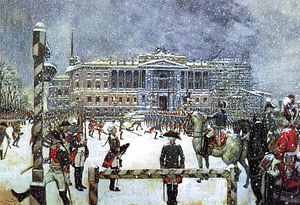 Military Parade of Emperor Paul in front of Mikhailovsky Castle painting by Alexandre Benois, taken from the art book World of Art.
Military Parade of Emperor Paul in front of Mikhailovsky Castle painting by Alexandre Benois, taken from the art book World of Art.
There is some evidence that Paul I was venerated as a saint among the Russian Orthodox populace,[51] even though he was never officially canonized by any of the Orthodox Churches.
Portrayals in literature, theatre and film
In 1906 Dmitry Merezhkovsky published his tragedy "Paul I". Its most prominent performance was made on the Soviet Army Theatre's stage (1989), with Oleg Borisov as Paul.
The 1987 Soviet experimental film Assa has a subplot revolving around Paul's murder; Paul is portrayed by Dmitry Dolinin.
A film on the rule of Paul I was produced by Lenfilm in 2003. Poor, Poor Paul ("Бедный бедный Павел") is directed by Vitaliy Mel'nikov and stars Viktor Sukhorukov as Paul and Oleg Yankovsky as Count Pahlen, who headed a conspiracy against him. The film portrays Paul I more compassionately than the long-existing stories about him. The movie won the Michael Tariverdiev Prize for best music to a film at the Open Russian Film Festival "Kinotavr" in 2003.
Issue
Paul and Sophie had ten total children; only nine survived to adulthood; eight had successful longevity:
Name Birth Death Notes Alexander I, Emperor of Russia 12 December 1777 19 November 1825 m. Luise Auguste, Princess of Baden (Elizabeth Alexeiyevna) (1779–1826), and had two daughters (both died in childhood). Grand Duke Constantin Pavlovich 27 April 1779 15 June 1831 married first Juliane, Princess of Saxe-Coburg-Saalfeld (Anna Feodorovna) [52], married second Countess Joanna Grudzińska morganatically. He had with Joanna one child, Charles (b. 1821) and 3 illegitimate children: Paul Alexandrov from first relationship; Constantine and Constance Constantinovichs from second relationship. Grand Duchess Alexandra Pavlovna 9 August 1783 16 March 1801 m. Joseph, Archduke of Austria, Count Palatine of Hungary (1776–1847), and had one daughter (died at birth). Grand Duchess Elena Pavlovna 13 December 1784 24 September 1803 m. Friedrich Ludwig, Hereditary Grand Duke of Mecklenburg-Schwerin (1778–1819), and had two children. Grand Duchess Maria Pavlovna 4 February 1786 23 June 1859 m. Karl Friedrich, Grand Duke of Saxe-Weimar-Eisenach (1783–1853), and had four children. Grand Duchess Catherine Pavlovna 21 May 1788 9 January 1819 married Georg, Duke of Oldenburg (1784–1812), had two sons; married Wilhelm I, King of Württemberg (1781–1864), and had two daughters. Grand Duchess Olga Pavlovna 22 July 1792 26 January 1795 Grand Duchess Anna Pavlovna 7 January 1795 1 March 1865 m. Willem II, King of the Netherlands (1792–1849), and had five children. Nicholas I, Emperor of Russia 25 June 1796 18 February 1855 m. Charlotte, Princess of Prussia (Alexandra Feodorovna) (1798–1860), and had ten children. Grand Duke Michael Pavlovich 8 February 1798 9 September 1849 m. Charlotte, Princess of Württemberg (Elena Pavlovna) (1807–1873), and had five children. Gallery
-
Family of Paul I of Russia, by Gerhard von Kügelgen
-
The rooms of Gatchina palace where Grand Duke Paul spent his youth
Ancestry
Ancestors of Paul I of Russia 16. Christian Albert, Duke of Holstein-Gottorp 8. Frederick IV, Duke of Holstein-Gottorp 17. Princess Frederica Amalia of Denmark 4. Charles Frederick, Duke of Holstein-Gottorp 18. Charles XI of Sweden 9. Princess Hedvig Sophia of Sweden 19. Princess Ulrika Eleonora of Denmark 2. Peter III of Russia 20. Alexis of Russia 10. Peter I of Russia 21. Natalia Naryshkina 5. Grand Duchess Anna Petrovna of Russia 22. Samuel Skowroński 11. Marta Helena Skowrońska
Catherine I of Russia23. Elisabeth Moritz 1. Paul I of Russia 24. John VI, Prince of Anhalt-Zerbst 12. John Louis I, Prince of Anhalt-Dornburg 25. Princess Sophie Auguste of Holstein-Gottorp 6. Christian August, Prince of Anhalt-Zerbst 26. Georg Volrath von Zeutsch 13. Christine Eleonore von Zeutch 27. Christine von Weissenbach 3. Princess Sophie of Anhalt-Zerbst
Catherine II of Russia28. Christian Albert, Duke of Holstein-Gottorp (= 16) 14. Christian August of Holstein-Gottorp, Prince of Eutin 29. Princess Frederica Amalia of Denmark (= 17) 7. Princess Johanna Elisabeth of Holstein-Gottorp 30. Frederick VII, Margrave of Baden-Durlach 15. Margravine Albertina Frederica of Baden-Durlach 31. Princess Auguste Marie of Holstein-Gottorp See also
- Manifesto of three-day corvee
- Tsars of Russia family tree
References
- ^ The 79 Grand Masters - official website of the Sovereign Order of Malta
- ^ McGrew (1992), 28.
- ^ McGrew (1992), 30.
- ^ Sorokin, 185.
- ^ McGrew (1992), 27. It is inconclusive whether Paul’s birth was legitimate, but historians largely agree that Catherine’s paramour Sergei Saltykov to be Paul’s father. See Mcgrew for a greater discussion of Paul’s paternity.
- ^ McGrew (1992), 78.
- ^ McGrew (1992), 78.
- ^ Sorokin, 183.
- ^ Sorokin, 185.
- ^ McGrew (1992), 149
- ^ McGrew (1992), 184.
- ^ Farquhar, Michael (2001). A Treasure of Royal Scandals, p.192. Penguin Books, New York. ISBN 0739420259.
- ^ For the Iranian expedition, see Haukeil, 349. For the 60,000 troops to Europe, see McGrew (1992), 282.
- ^ Haukeil, 351.
- ^ McGrew (1992), 283.
- ^ McGrew (1992), 286.
- ^ McGrew (1992), 289.
- ^ McGrew (1992), 288–89.
- ^ McGrew (1992), 289–90.
- ^ McGrew (1992), 286–87.
- ^ Haukeil, 351.
- ^ McGrew (1979), 46–48.
- ^ McGrew (1979), 48.
- ^ McGrew (1979), 49–50.
- ^ McGrew (1979), 51.
- ^ McGrew (1979), 55–58.
- ^ McGrew (1979), 59.
- ^ Haukei, 355-57.
- ^ McGrew (1992), 299.
- ^ Haukeil, 358.
- ^ For Archduke Charles withdrawing early, see McGrew (1992), 301. For more information on the battles Korsakov and Suvorov fought, see Haukeil, 361-62.
- ^ For a summary of the taking of Ancona, see McGrew (1992), 306. For a quick summary of all the issues involved, see Hugh Ragsdale, “A Continental System in 1801: Paul I and Bonaparte,” The Journal of Modern History, 42 (1970), 70–71.
- ^ McGrew (1992), 309.
- ^ For a summary of the Netherlands campaign, see McGrew (1992), 309. For a more detailed look at the events, with a slight British bias, see Haukeil, 364.
- ^ Haukeil, 364.
- ^ McGrew (1992), 309–310.
- ^ McGrew (1992), 311.
- ^ For a summary, with more information on Paul growing closer to the Baltic states, see McGrew (1992), 311–12. For information on the English ambassador and their choice of Austria over Russia, see Ragsdale, “A Continental System in 1801: Paul I and Bonaparte,” The Journal of Modern History, 71–72. For Napoleon’s actions and Paul’s feelings towards him, see Haukeil, 365.
- ^ For information on the Danish frigate, see Hugh Ragsdale, “Was Paul Bonaparte’s Fool?: The Evidence of Neglected Archives,” in Paul I: A Reassessment of His Life and Reign, ed. Hugh Ragsdale (Pittsburgh: University Center for International Studies, University of Pittsburgh, 1979), 80. For Paul’s reaction to the seizure and then the events at Malta, see McGrew (1992), 313–14. For the date of the Maltese events, and a more English view of them, see Haukeil, 366.
- ^ For a summary of Paul’s reaction, see McGrew (1992), 314. For more details, see Haukeil, 366.
- ^ For information on the military side of these measures, see McGrew (1992), 314. For information on the economic side and how Paul interacted with the Armed Neutrality, see Ragsdale, “Was Paul Bonaparte’s Fool?” in Paul I: A Reassessment of His Life and Reign, 81.
- ^ Ragsdale, “A Continental System in 1801: Paul I and Bonaparte,” The Journal of Modern History, 81–82.
- ^ Haukeil, 366.
- ^ McGrew (1992), 314.
- ^ For arguments about consistency and Paul’s reasons to fight, see McGrew (1992), 318. For the arguments as to why Paul was willing to reach an agreement with Bonaparte, see Muriel Atkin, “The Pragmatic Diplomacy of Paul I: Russia’s Relations with Asia, 1796–1801,” Slavic Review, 38 (1979), 68.
- ^ Atkin, “The Pragmatic Diplomacy of Paul I,” 68.
- ^ Atkin, “The Pragmatic Diplomacy of Paul I,” 69.
- ^ Ragsdale, “Was Paul Bonaparte’s Fool?” in Paul I: A Reassessment of His Life and Reign, 88.
- ^ Alexander II, The last great tsar, by Edvard Radzinsky. Page 16–17. Freepress, 2005.
- ^ The Reverend Michael Foster (2001) Emperor Paul I of Russia, and his Russian Grand Priory of the Order of Saint John of Jerusalem.
- ^ Zhevakhov, Prince N. D. (1993) Reminiscences, V.2, p.273. Moscow.
- ^ http://www.angelfire.com/pa/ImperialRussian/royalty/russia/dukes.html
 This article incorporates text from a publication now in the public domain: Chisholm, Hugh, ed (1911). Encyclopædia Britannica (11th ed.). Cambridge University Press.
This article incorporates text from a publication now in the public domain: Chisholm, Hugh, ed (1911). Encyclopædia Britannica (11th ed.). Cambridge University Press.
Bibliography
- Haukeil, Henry A. and Tyrrell, H., The History of Russia from the foundation of the Empire to the War with Turkey in 1877–78, Volume 1 (London: The London Printing and Publishing Company, Limited, 1854)
- McGrew, Roderick E. (1979) “Paul I and the Knights of Malta,” in Paul I: A Reassessment of His Life and Reign, ed. Hugh Ragsdale (Pittsburgh: University Center for International Studies, University of Pittsburgh ISBN 0916002284, pp. 44 ff.
- McGrew, Roderick E. (1992), Paul I of Russia. (Oxford: Clarendon Press) ISBN 0198225679
- Sorokin, Iurii Alekseevich (1996). "Emperor Paul I, 1796–1801" in The Emperors and Empresses of Russia: Rediscovering the Romanovs, ed. Donald J. Raleigh (Armonk, NY: M.E. Sharpe) ISBN 1563247593.
Further reading
- 1979 Reassessment of Paul: Hugh (Ed) Paul I: A reassessment of His Life and Reign, University Center for International Studies, University of Pittsburgh, 1979[citation needed]
- For Paul's early life: K. Waliszewski, Autour d'un trone (Paris, 1894), or the English translation, The Story of a Throne (London, 1895), and P. Morane, Paul I. de Russie avant l'avenement (Paris, 1907)
- For Paul's reign: T. Schiemann, Geschichte Russlands unter Nikolaus I (Berlin, 1904), vol. i. and Die Ermordung Pauls, by the same author (Berlin, 1902)
- Other readings: (in Russian) V.V.Uzdenikov. Monety Rossiyi XVIII-nachala XX veka (Russian coinage from 18th to the beginning of 20th century). Moscow – 1994. ISBN 5-87613-001-X
- Palmer, Elena."Peter III. Der Prinz von Holstein". Sutton, Germany, 2005 (ISBN 3-89702-788-7).
External links
- Emperors and Empresses of Russia: Paul I
- Alexanderpalace.org
- (Russian) Pavel I – Prince of Gatchina. Digest & "Bednyy, bednyy Pavel". Film Vitaliy Melnikov about Paul I of Russia
- Tsar Paul and the Question of Madness by Hugh Ragsdale
- Godunov to Nicholas II by Saul Zaklad
Emperor Paul I of RussiaBorn: 1 October 1754 Died: 23 March 1801Regnal titles Preceded by
Catherine IIEmperor of Russia
6 November 1796 – 23 March 1801Succeeded by
Alexander IGerman nobility Preceded by
Karl Peter UlrichDuke of Schleswig-Holstein-Gottorp
1762–1773Ceded to Denmark Preceded by
Karl Peter Ulrich and
Frederick V of Denmark and Norway
(in condominial rule)Duke of Holstein
condominial rule with Frederick V (till 1766) and thereafter with the latter's son Christian VII
1762–1773
under guardianship due to minoritySucceeded by
Christian VII of Denmark and Norway
(continued as the sole duke regnant after the major Paul waived Holstein in favour of Oldenburg)Preceded by
ChristianCount of Oldenburg
1773Succeeded by
Friedrich AugustHonorary titles Preceded by
Ferdinand von Hompesch zu BolheimGrand Master of the Knights Hospitaller
1798–1801Succeeded by
Nikolay SaltykovRussian royalty Preceded by
Peter III of RussiaHeir to the Russian Throne
1762–1796Succeeded by
Alexander I of RussiaRussian Tsareviches and Tsesareviches Grand Dukes of Russia 1st generation - Tsarevich Alexei Petrovich
- Alexander Petrovich
- Paul Petrovitch
- Peter Petrovich
2nd generation 3rd generation 4th generation - Paul I
5th generation 6th generation - Alexander II
- Grand Duke Constantine Nicholaevich
- Grand Duke Nicholas Nicholaevich
- Grand Duke Michael Nicholaevich
7th generation - Tsarevich Nicholas Alexandrovich
- Alexander III
- Grand Duke Vladimir Alexandrovich
- Grand Duke Alexei Alexandrovich
- Grand Duke Nicholas Constantinovich
- Grand Duke Nicholas Nicholaevich
- Grand Duke Sergei Alexandrovich
- Grand Duke Constantine Constantinovich
- Grand Duke Nicholas Mikhailovich
- Grand Duke Dimitri Constantinovich
- Grand Duke Paul Alexandrovich
- Grand Duke Michael Mikhailovich
- Grand Duke Viacheslav Constantinovich
- Grand Duke George Mikhailovich
- Grand Duke Peter Nicholaevich
- Grand Duke Alexander Mikhailovich
- Grand Duke Sergei Mikhailovich
- Grand Duke Alexei Mikhailovich
8th generation - Nicholas II
- Grand Duke Alexander Alexandrovich
- Grand Duke George Alexandrovich
- Grand Duke Alexander Vladimirovich
- Grand Duke Cyril Vladimirovich
- Grand Duke Boris Vladimirovich
- Grand Duke Michael Alexandrovich
- Grand Duke Andrew Vladimirovich
- Grand Duke John Constantinovich*
- Grand Duke Dimitri Pavlovich
9th generation 10th generation 11th generation - *born a Grand Duke, but stripped of his title by Alexander III's ukase of 1886, limiting the style to sons and male-line grandsons of a tsar
- **title of pretence granted by Grand Duke Cyril Vladimirovich as claimant to the Russian throne
- ***title of pretence granted by Grand Duke Vladimir Cyrillovich as claimant to the Russian throne
Categories:- 1754 births
- 1801 deaths
- 1801 crimes
- Russian emperors
- Eastern Orthodox Christians from Russia
- House of Holstein-Gottorp-Romanov
- Dukes of Holstein
- Russian grand dukes
- Grand Masters of the Knights Hospitaller
- Knights of Malta
- People from Saint Petersburg
- Murdered Russian monarchs
- Orthodox monarchs
- Burials at Peter and Paul Cathedral
- Recipients of the Order of St. Andrew
-
Wikimedia Foundation. 2010.

